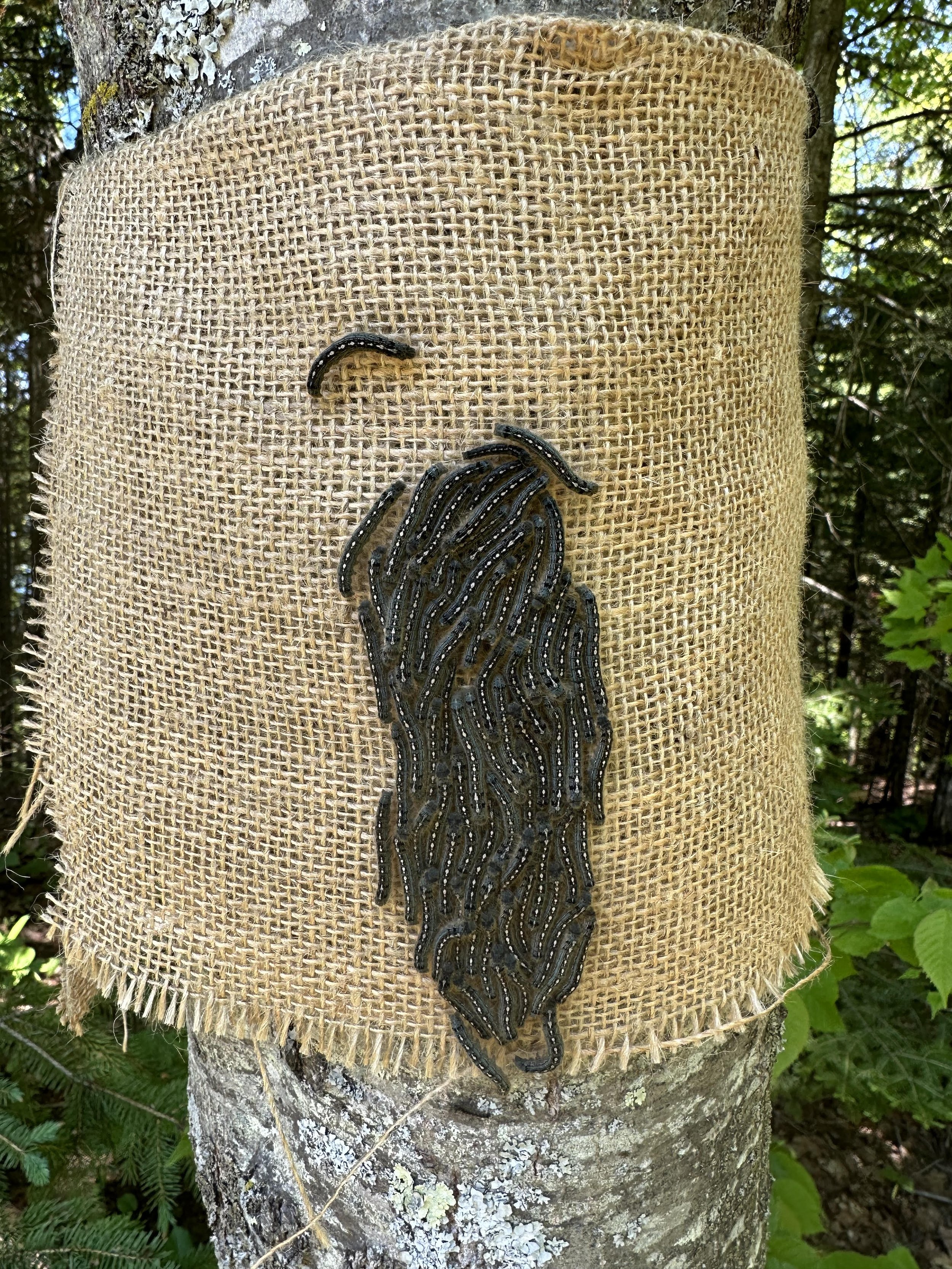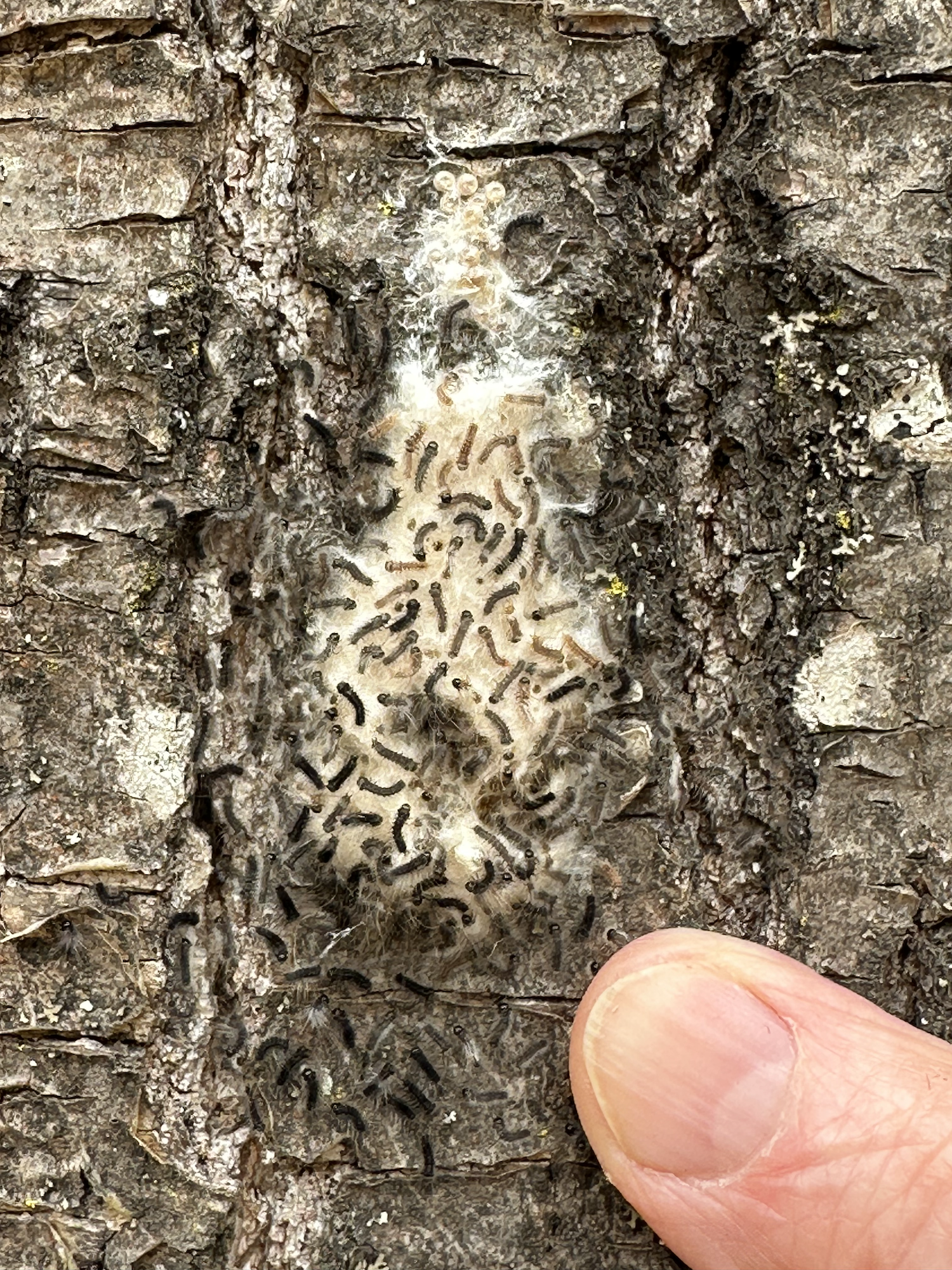Spongy Moth Update — What You Need to Know!
/Spongy Moth: Update June 15, 2023
IT’S NOT TOO LATE TO PUT BURLAP BANDS ON YOUR YARD TREES!
From WI DNR June 9, 2023: “Wisconsin Department of Natural Resources Forest Health staff are cautioning Wisconsin residents that the next two months could bring the worst spongy moth outbreak in more than a decade.”
Spongy Moth (SM) egg hatch on the island began mid-May and is almost done, leaving a percentage of egg masses that do not hatch, which is normal. Tiny when they first emerge, the SM caterpillars are growing quickly. I watch them eating the leaves on oak saplings in our yard, as well as other kinds of trees and shrubs (see Photo 1). There is hope that two diseases that kill SM will be prevalent and effective this year. One is a naturally occurring virus and the other is an introduced fungus. Mortality should be most noticeable between mid-June and mid-July.
I also see feeding in the crowns of oak, birch and aspen, but it’s difficult to tell if this is all due to SM caterpillars because there is at least one, maybe two other caterpillars that are also feeding on our trees and shrubs this year. Forest Tent Caterpillars (FTC, sometimes called army worms) favor aspen, sugar maple, oaks and birch, and at this time are larger than the SM caterpillars as they hatch earlier (see Photo 2). Eastern Tent Caterpillars (ETC) are emerging now (see Photo 3). They favor black cherry, apple and crabapple trees, and often produce a dense web in branch crotches.
Management: Water yard trees weekly during dry periods
FTC and ETC are native pests, and on their own aren’t generally a threat to the long-term health of forests compared to SM. However, the combined impact of these three defoliating pests this summer may be significant for yard trees as well as over larger forested areas. Management recommendations for SM will also help manage FTC and ETC. At this time, options to protect yard and high-value trees include burlap collection bands, physically destroying caterpillars and applying insecticides.
The following information is directly mainly from two main sources: WI DNR Forestry News, June 9, 2023, and Management Guide for Homeowners, Spongy Moth Fact Sheet, UW Extension (see links below).
Make a burlap band: When spongy moth caterpillars are about one inch long, many will begin a daily migration down the tree to hide from predators and heat. You can take advantage of this behavior by creating a band of burlap that the caterpillars can hide under, so that you can destroy them. Cut a piece of burlap 12 to 24 inches wide and long enough to completely wrap around the tree at chest height. Tie a piece of string around the middle of the burlap and fold the upper portion down to form a “skirt” around the tree (see photo 3). Every afternoon, check under the burlap and brush the caterpillars into a bucket of soapy water to kill them. The burlap bands can be removed in July or August, once the caterpillars are no longer seen. Watch this video showing how to use a burlap collection band to catch and kill spongy moth caterpillars.
Apply Insecticides: These can be a suitable option for high-value host trees but are not practical for woodlots. Because bacterial insecticides must be applied while the caterpillars are smaller than one-half inch long, it is too late this year for them to be effective. Numerous conventional insecticides are labelled for control of spongy moth caterpillars in Wisconsin. Some of these products are intended for use by tree care professionals, while other products may be available at your local garden center or hardware store. Check the label to make sure spongy moths (formerly known as “gypsy moths”) are listed on the label.
Foliar Sprays: A common approach is to spray foliage to prevent feeding damage by spongy moth caterpillars. Common insecticide ingredients labelled for spongy moth include bifenthrin, carbaryl, cyfluthrin, cyhalothrin, cypermethrin, deltamethrin, permethrin, and others. These ingredients typically protect treated foliage for a week or two and multiple applications may be needed to maximize protection against spongy moth caterpillars. Thorough spray coverage is also needed as untreated foliage will not be protected. Foliar treatments are most effective against small caterpillars and may struggle against large caterpillars. While homeowners may be able to spray small trees (e.g., < 10-15 feet tall), larger trees will generally need to be treated by an arborist to achieve good spray coverage.
Organic and reduced-impact sprays: Like Btk, certain foliar spray products can pose fewer risks to other insects. This group includes insecticidal soaps, horticultural oils, pyrethrins, and spinosad. The soaps, oils, and pyrethrins only kill when sprayed directly onto spongy moth caterpillars and are very short-lived. While they can be a good option small plants (e.g., small trees or shrubs), these ingredients are not a good option for larger trees.
Systemic Treatments: While foliar treatments must be sprayed directly onto foliage, some products can move systemically within plants after being applied to the soil or the lower trunk. A few systemic ingredients are labelled for spongy moth, such as acephate, clothianidin, dinotefuran, and emamectin benzoate. While a few systemic products are available to homeowners, many products in this group are for use by tree care professionals and may require specialized training and/or equipment to apply.
The products in this group have notable caveats: 1) systemic products can pose concerns for bees and other pollinators, 2) some systemic ingredients have slow uptake (several weeks) 3) large trees can require large doses of the insecticidal ingredient and homeowners may not be able to legally apply a sufficient dose to fully protect large trees 4) many systemic products have limits on the amount that can be applied to a given area (acre) per year, so systemic products are generally not appropriate for large areas and/or large numbers of trees 5) due to the costs, systemic products can be a consideration for small numbers of high value trees but are not feasible for large numbers of trees.
Wait to cut down any trees that are defoliated. Healthy hardwood trees usually produce a new set of leaves a few weeks later.
In July: “Crush & brush” pupae and adult females
Remember: Avoid touching the hairy caterpillars and shed skins that fall on outdoor furniture, as well as the moths and egg masses that will appear later in the summer. The hairs often cause a skin rash, welt, or other irritation. Rubbing alcohol can help to remove the hairs and chemical irritants from skin that is exposed to the hairs.
I am not scheduling any more outreach sessions at this time but I am happy to answer any questions. Please call, text or email me. Kathy Kromroy at 651-271-5825 and kathrynkromroy@gmail.com
Links to helpful online sites
What are the differences among Spongy Moth, Forest Tent, and Eastern Tent caterpillars?
Management
https://forestrynews.blogs.govdelivery.com/2023/06/09/spongy-moth-forecast-caution-issued/
https://forestrynews.blogs.govdelivery.com/2023/06/09/diseases-take-aim-at-spongy-moth/
General information

























